|
Getting your Trinity Audio player ready...
|
Established in 2013
Pinnacles National Park is where California condors soar over volcanic outcrops. Lace up your hiking boots and head out on steep hikes along the park’s trademark cliffs or explore the hidden talus caves.
Tucked away in the hills above the Bay Area is one of the US’s newest national parks. Many people overlook it, driving several hours further to see Yosemite or Sequoia.
What are the odds that those millions of visitors who choose to battle for space in California’s biggest parks are missing a hidden gem? Pretty high, actually.
In this article, we’ll share what we love about Pinnacles National Park. If you’re an adventurer looking for a different kind of outdoor experience, this is the place to start. Everything you need to see and do to experience Pinnacles is right here.
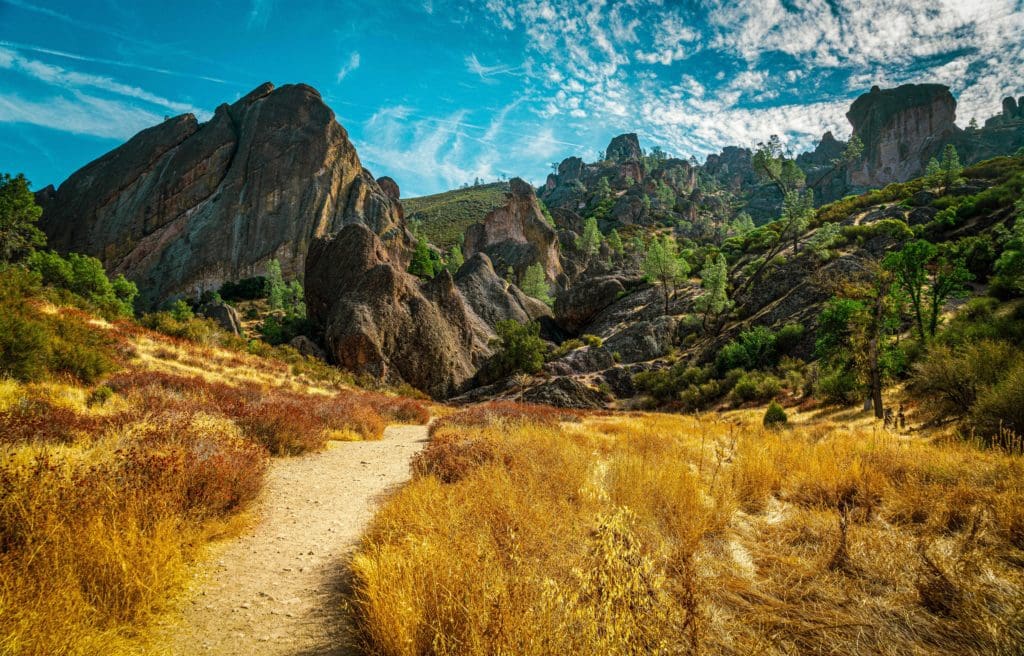
Trail through Pinnacles National Park.
The Human History of Pinnacles National Park
The history of humans in Pinnacles stretches back thousands of years. Archaeological sites containing stone tools put Native Americans of the Ohlone people in the park as far back as 2,000 years.
But it’s possible that the Ohlone lived there much longer. These coast-dwellers are descended from some of North America’s first people. It’s suspected that the Pinnacles area has been inhabited for around 10,000 years.
Our best guess is that the Ohlone used Pinnacles as a harvesting and hunting ground. There are 13 archaeological sites around the park, all of which remain unmarked for protection. From what we know of their lives, the pre-colonial Ohlone culture was highly diverse. As many as 50 distinct subgroups are known to exist today.
The Ohlone way of life changed dramatically with the arrival of the Spanish. Over the course of about a century, Spanish missionaries waged genocide on Pinnacles’ native peoples. By the time Protestant settlers arrived in the early 1800s, Pinnacles was a desolate wilderness entirely devoid of people.
The 1800s were a time of widespread change in California. The state became part of Mexico, then was reclaimed by the US. Outlaws and miners ranged through the Coast Ranges, including Pinnacles.
By the end of the century, homesteader Schuyler Hain arrived in Pinnacles. He notably led tours through the park’s talus caves and advocated for preserving the area. This caught the attention of the president of Stanford, Congressman James Needham, and eventually Theodore Roosevelt.
Roosevelt first protected the park as Pinnacles Forest Reserve in 1906, then established it as a National Monument in 1908. It remained a monument for over 100 years. During this century, it was enlarged several times, added roads, dams, and buildings, and became part of the history of rock climbing. Finally, in 2013, President Obama named Pinnacles a national park.
Geology of The Pinnacles
To say Pinnacles National Park is a geological oddity is an understatement. From a distance, its craggy, rugged exterior looks like any other pile of rocks. But up close, the mounds of volcanic conglomerate stone that make up the park are truly strange.
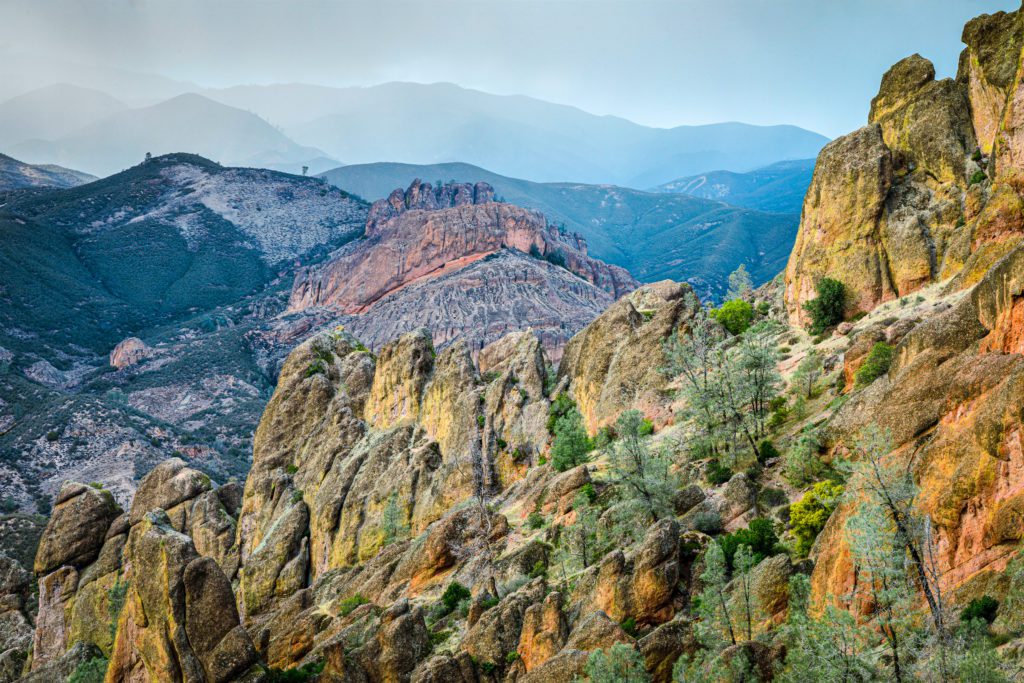
Volcanic Rocks at High Peaks during a winter sunset. Pinnacles National Park.
So how did they get here? The short answer is volcanism. The park’s rock was created by a volcanic eruption roughly 23 million years ago. During this eruption, the movement of tectonic plates divided the volcano and carried it almost 200 miles to the northwest.
As this entire mountain was casually picked up and carried by a tectonic plate, erosion worked its magic. Wind and water chiseled away at the cobbled breccias, weathering them into colossal, rounded boulders.
But as it was carried, it was also shaken apart. The movement of the plates caused strong earthquakes which split the bedrock. These newly-formed, round behemoth rocks fell into the gaps, wedged together, and stuck in place. In short, that’s how you end up with a talus cave.
If you’re not getting the image, talus are huge chunks of stone that break off of mountains and roll away. In Pinnacles, these boulders are especially huge.
So much so, that when they get jammed into crevices formed by earthquakes, they can make large caves. Pinnacles and Yosemite are the two best examples of this weird geological phenomenon.
But while the park could easily be named “Talus Caves National Park,” it’s the pinnacles themselves that stand out. The park’s most dramatic feature are the smoothly-curved stone spires looming above the little river valleys below.
Though they may look smooth from a distance, these walls are really just rubble cemented together. As we’ll discuss in a bit, this is what makes rock climbing in Pinnacles so perious. But the strange breccia pillars, mostly andesite and rhyolite, produce spectacular panoramas across the park.
Coast Range Ecology
If you’re visiting Pinnacles midsummer, with the baking sun lording over you, it’s hard to imagine that much wildlife could survive here. But Pinnacles is teeming with a diverse cast of flora and fauna.
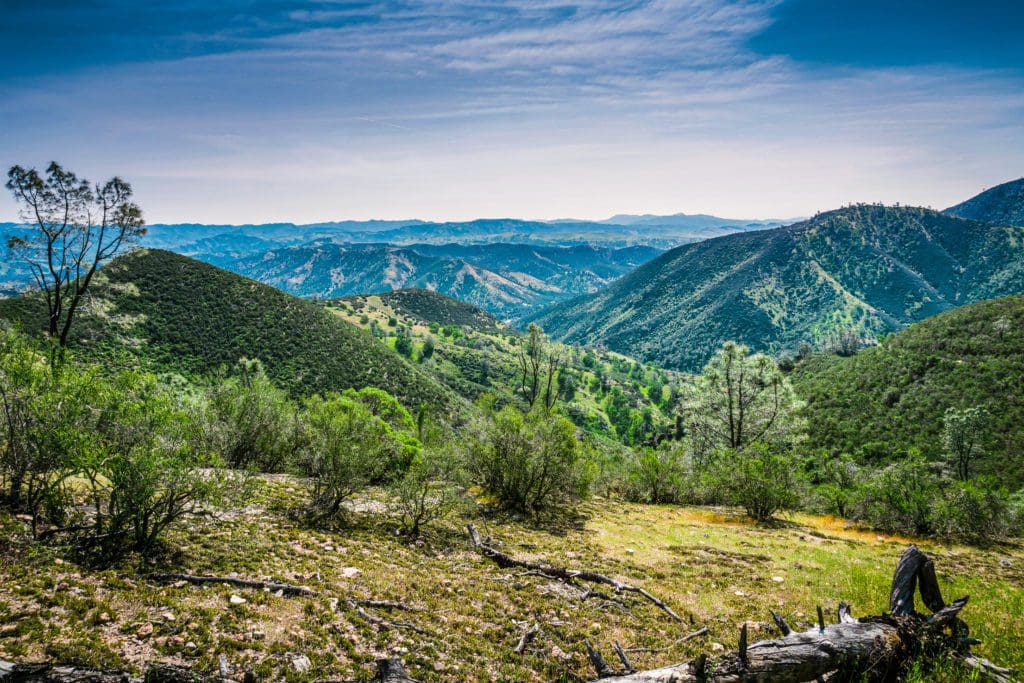
View from the high peaks trail towards the chaparral filled valleys and hills of Pinnacles National Park, California.
Ecologically, the main backdrop we see in Pinnacles is the chaparral. This community thrives in the arid, hot foothills of the Sierra Nevada, composed of heat-tolerant plant species.
Driving into the park, you won’t see many trees. The surrounding area is mostly dense grassland, which becomes a mixed woodland of oak as you gain elevation. Higher up, in cooler pockets, you’ll find pines with long, wispy needles.
At a glance, it’s easy to form a picture of pinnacles as desert-like. But there is a surprising amount of water here. And the narrow, winding canyons between the park’s rock spires are host to cool riparian zones.
In these pockets of moisture, biodiversity skyrockets. Willow, elderberry, and huge sycamores shade the babbling creek beds.
Under the water, you may see any of the park’s eight amphibian species. These include a surprising number of salamanders, like the ensanita and tiger salamander.
Further from water, you begin to find the park’s many reptiles. A fairly traditional “Wild West”-type cast of mammals also wander the Pinnacles. These include foxes, coyotes, jackrabbits, cougars, badgers, and mule deer.
Even more interesting are the park’s bats. There are 16 bat species in Pinnacles, a higher number than any other group of mammals. This is due largely to the park’s talus caves, which are an ideal habitat for bug-hungry night flyers.
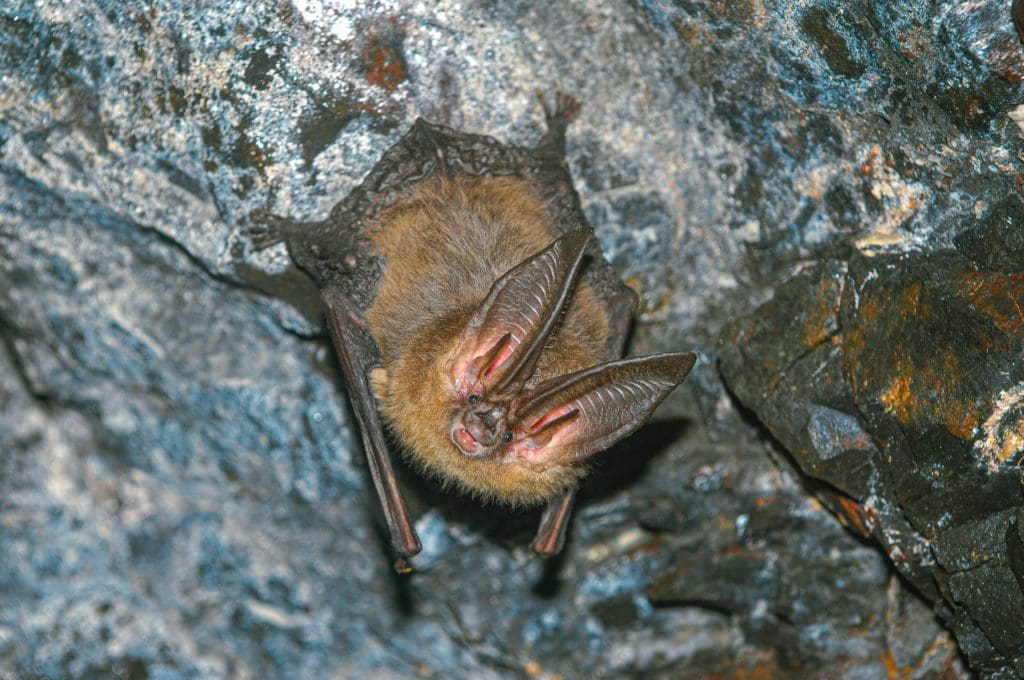
Townsend’s big-eared bat hanging in cave.
Notably, Bear Gulch Cave contains the largest maternity roost of Townsend’s big-eared bats in California. This site is of crucial importance to bat populations in the area. And it is all the more important due to the threat of White-nose Syndrome.
If you’re unaware, White-nose Syndrome is a disease which is fatal to many species of American bats. It’s spread by a soil fungus, which can live on the boots and clothes of human cave explorers. Since it first came to the US in 2009, White-nose Syndrome has infected and killed over 10 million bats across the country.
But luckily, Pinnacles is still (we hope) free of White-nose Syndrome. Because of its importance as bat habitat, it is essential that we keep this disease out of the park. So what can you do? The short answer is caving smart and planning ahead. If you’ve ever been in a cave with White-nose Syndrome, don’t take any clothing or gear from that cave into any other cave.
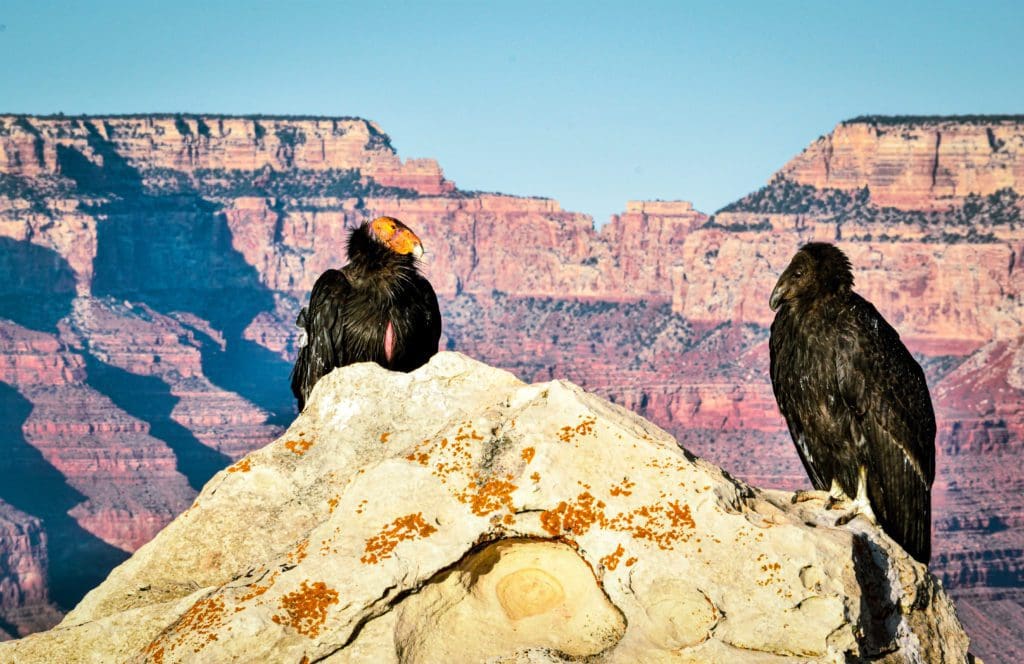
2 California Condors sitting on rock.
The park’s bats aren’t its only flying residents. Some of the most inspiring animals in the park are its birds. We’re talking in general about the many colorful woodpeckers, owls, falcons, jays, and juncos around the park. But specifically, we mean one species: the majestic California condor.
Since the California condor became functionally extinct in 1987, several intense conservation efforts have cropped up to recover their populations. Today, Pinnacles is one of the most important condor reintroduction sites. Because of this, it’s also one of the best places to see North America’s largest bird.
How to Get to Pinnacles National Park and Where to Stay
One of the best things about Pinnacles is how close it is to the Bay Area. The east entrance is just a 90 minute drive from San Jose.
That said, you will probably plan your trip to Pinnacles around which side of the park you want to see. The park has two main roads, one on the east side and another on the west. They don’t connect, so in order to see the other side you’ll have to drive out and around.
Most people primarily visit the east side of the park. This is where the park’s only campground is located.
The west side is decidedly more rugged and remote, but it’s also close to some of the best hikes in Pinnacles. If your idea of fun is solitude in the wilderness (which we applaud), the western entrance is well worth your time.
Main Attractions in Pinnacles
If you’re new to Pinnacles, there are a few boxes you’ll want to check. Here are the big must-see attractions in Pinnacles National Park.
Talus Caves
There are other talus caves in the world. But not like those in Pinnacles. The sheer scale of the caves in Pinnacles is awe-inspiring.
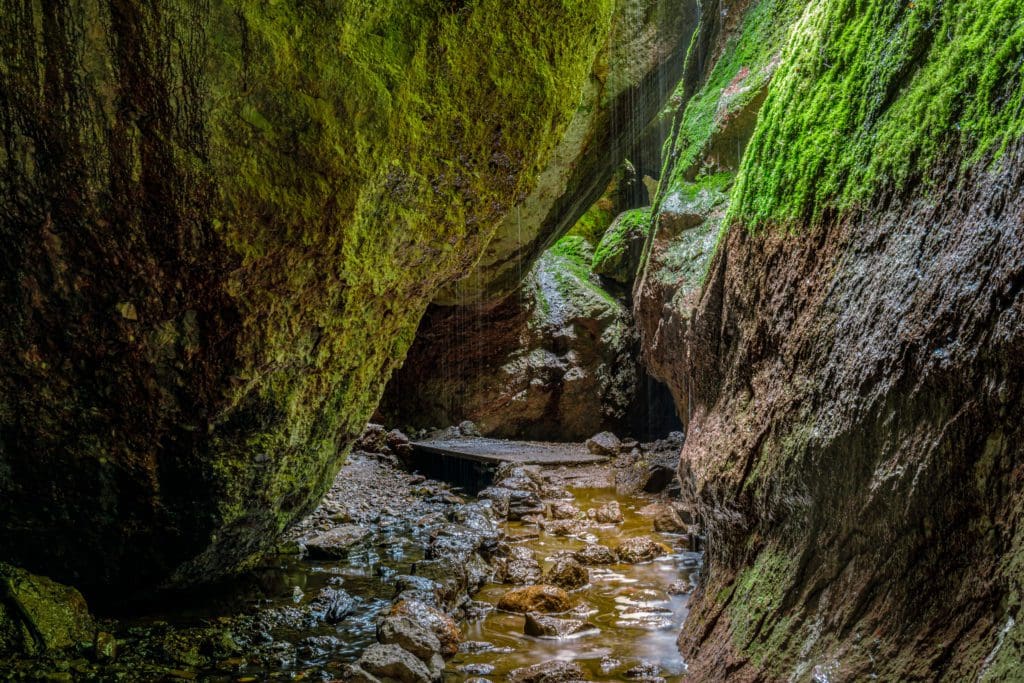
Bear Gulch lower cave on a rainy day.
Most caves feel like a winding passage of slick, smooth rock. But being inside a talus cave is more like being an ant, crawling through a pile of fist-sized rocks. Everything is precariously balanced and wedged in place. You’ll stand in a room with a 30 foot high ceiling, formed by a boulder that measures 40 feet across.
Though it all looks sort of delicate, the caves have been sitting in their current state for millions of years. Touring the dark spaces under the earth is a sensation like none other.
High Peaks Trail Loop
An extension of the short trail to Bear Gulch Cave, the High Peaks Trail is dense with fantastic views of the Pinnacles. Prepare yourself for some steep climbs, bring extra water, and don’t forget your camera.
If you only have one full day in the park and want to get a sense for what the interior of the park’s wilderness looks like, this is the way to do it. The high peaks loop crosses through mountaintops, where you can spot condors in flight. Then it plunges back into the narrow canyon bottoms to the only still body of water in the park, Bear Gulch Reservoir.
Wildlife Watching
You came all this way from the city to see some nature, and now you’re in it. There are fascinating creatures and plants on all sides in Pinnacles National Park. Your binoculars should always be within arm’s reach here.
The main thing everyone in the park is looking for is the California Condor. But condors are hardly the only bird worth looking (or listening!) for. Road runners, canyon wrens, thrashers, and Lewis’ woodpeckers can all be found in the park. Like with most places, having success birding in Pinnacles is all about being in the right place at the right time.
But that’s not all. There are a huge number of other incredible species here. The park’s waterways hold amphibians and reptiles like the pond turtle. In dry areas you may spot any of 8 lizard species, or even a tarantula.
Things to Do in The Park
When planning a trip, it’s good to have some variety on the agenda. These are the best ways to spend your time in Pinnacles National Park.
Hiking in Pinnacles National Park
Like with any trip to a national park, hiking should always be on the agenda. Pinnacles, despite its relatively small size, has a ton of trails to explore.
But be warned, adventurer. The summer heat in Pinnacles can be fatal. Before setting out, make sure you have enough water, and then some.
Here are a few highlights.
Condor Gulch to The High Peaks Loop
As stated above, the High Peaks Loop is the best way to dip your feet in what Pinnacles has to offer. Your best chance of seeing a condor is here. It’s also a prime trail for viewing the park’s strange rock formations.
All told, the trail covers about five and a half miles and gains roughly 1,700 feet of elevation along the way. Most visitors start from the eastern entrance. But you can also approach from the west, using part of the High Peaks and Balconies trail.
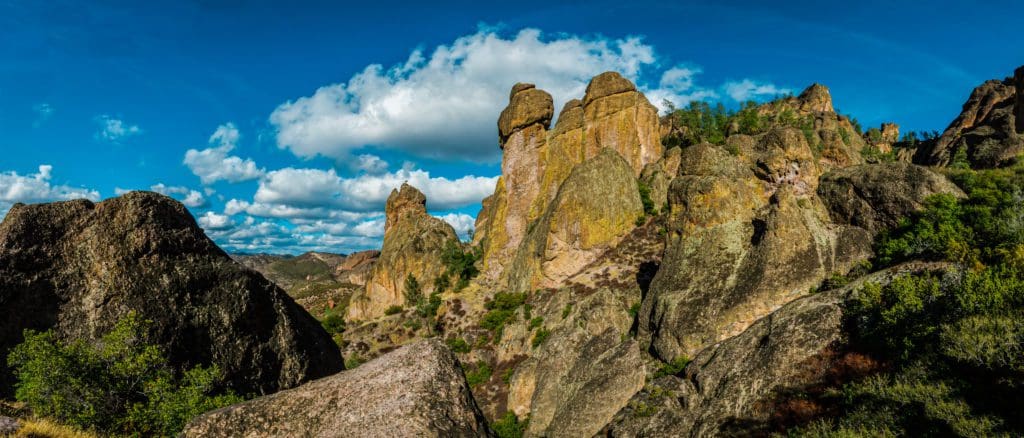
Flow-Bbanded rhyolite volcanic spires on the High Peaks Trail in Pinnacles National Park.
High Peaks and Balconies Trail
If the High Peaks Loop is a little mild for your taste, the High Peaks and Balconies trail tacks on some extra mileage. In this case, a little extra sweat goes a long way. This variation crosses through much more interesting terrain, including the entrance to Balconies Cave.
In total, High Peaks and Balconies traverses nine and a half miles and climbs roughly 2,000 feet. A swift hiker could call it a half day. But most folks (particularly those who like to soak in the views) will take a full day. This trail is very easy to access from either entrance, and actually connects them together.
North Wilderness Loop (and Variations)
Like with many National Parks, most Pinnacles visitors only see about 10% of the park. The North Wilderness Loop lets you get off the beaten path and into the backcountry.
The main version of this trail begins at the west entrance, heading north. It meanders up and down through the park’s dense wilderness, curving back south. Then, it links back up with the Balconies Trail and loops to the trailhead.
But another version, which tacks on five more miles, includes parts of the High Peaks Loop.
This trail is a true adventure, crossing through all the different corners of the park. You’ll see everything from huge peaks and stone spires to lakes and caves. It’s enough distance and gain for just about anybody to work up a sweat.
Camping
Even though it’s close to the Bay Area, Pinnacles National Park is very remote. There isn’t much in the way of lodging near the park, so most visitors camp.
The park has just one campground, but it’s a lovely, shaded area. In total, Pinnacles Campground has 134 sites, most of which border a creek.
This presents a nice taste of what riparian areas in the park are like. The babbling stream is watched over by large sycamores, and is a great place to spot wildlife.
Rock Climbing
Given its proximity to the mecca that is Yosemite, most climbers don’t even consider Pinnacles. But that’s part of the magic that makes it such an interesting place to climb.
Pinnacles National Park is one of the places where the sport of climbing got its start. Many Yosemite legends trained on the chossy, “challenging” rock of the Pinnacles. And today, there is still a contingent of diehards that love climbing here.
But to say that Pinnacles is even a “popular” climbing area is misleading. In the mainstream, climbers disparage Pinnacles for its crumbly rock, hot conditions, and sandbagged routes. The upshot of this is it leaves more space for the rest of us.
The truth about climbing in Pinnacles lies somewhere between two extremes. It truly is an excellent training ground, and its proximity to the Bay Area is a huge plus. And while it may be fraught with challenges, the fact is that all outdoor climbing is.
Climbers in the modern era tend to forget that nature is gritty, harsh, and won’t always give up easily. If you’re new to climbing in the outdoors and want to steel yourself for real adventure, Pinnacles will show you the ropes.
Most of the climbing in the park is sport, with a fair amount of trad as well. Bouldering is discouraged because of how chossy the rock can be.
The routes range from easy and tall, like Costanoan to short and intense, like Feed the Beast. The difficulty maxes out around 5.12b, with a few 13’s and 14’s. Most of the really hard stuff is on the Monolith. Most of the park’s classic climbs are around 5.10 or 11, like Get Smart and P.O.D.
With many of these routes, the crux is some kind of runout. Protection here can be funky, and the rock is often questionable, but that’s part of the point. Pinnacles doesn’t just hand you victories. Climbing here takes more than just muscle and skill. It makes you think like one of climbing’s pioneers, who had to improvise constantly, and endure.
Caving
You can’t really say you saw Pinnacles without experiencing its caves. Or rather, cave. Balconies Cave has been closed indefinitely due to vandalism. It’s an all-too real reminder of how fragile cave ecosystems are, and the impacts of human carelessness.
That said, you can still visit Bear Gulch Cave. This is the cave that is home to a huge maternity colony of Townsend’s big-eared bats. Because of the importance to bats, parts of the cave may be closed at different times.
So when planning a trip to the park, it’s wise to plan around the bats, and the weather. Accessing Bear Gulch Cave requires a 2.6-mile round trip hike, which may bar some visitors entirely. Most visitors will start from the eastern entrance, park, hike in, and then explore the cave.
When touring these dark and silent corners of the earth, it’s essential that we leave no trace and cave smart. The unique wonder of the underground world is mysterious and unique. But life here is also delicate.
Birding and Nature Watching
Pinnacles National Park is a hub of biodiversity in the Coast Ranges. As we’ve already mentioned, there are boatloads of rare species here. The biggest and most notable is the California condor, which can be seen in the park’s higher reaches.
But the list doesn’t end there. The park’s bird list includes 160 species. The coveted gems of this list are Lewis’ woodpeckers, long-eared owls, double-crested cormorants, ospreys, and calliope hummingbirds.
The park is also quick to note that 37% of the species listed in their inventory were observed during the annual Audubon Christmas Bird Count. You can help the park better understand its wildlife resources by participating.
Beyond birds, there are interesting fauna of every stripe in Pinnacles. From the threatened red-legged frog, which can be seen in Bear Gulch Reservoir, to the odd-looking Western Mastiff Bat, you can find amazing wildlife everywhere you look.
Nights are particularly productive for wildlife watching. The park’s 16 bat species can be glimpsed overhead or observed darting over water as they hunt. Owls peer from rookeries and trees. Frogs sing and tarantulas roam.
And what’s even better is that your hobby can contribute to science. Getting involved in a citizen science project or using a tool like iNaturalist can help further our understanding of the natural world.
An Underrated Gem
Pinnacles National Park is one of the country’s newest. It’s a small, rocky pocket of wilderness where giant birds soar. It’s often overlooked in conversations about California’s amazing national parks. But any adventurer would be remiss not to see what it has to offer.
Skyblue Overland Strongly Recommends That You Enroll With Global Rescue Prior To Embarking On Your Next Adventure.
Purchase a Global Rescue membership for your next adventure and travel with peace of mind. Single trip, annual and family options are available.
Learn More!
Popular Articles:
Brighter Night: Colorful Night Ice Climbing in Alaska’s Mendenhall Glacier
Skiing the Herman Gulch Backcountry Area, Colorado
Adventurer’s Guide to North Cascades National Park











